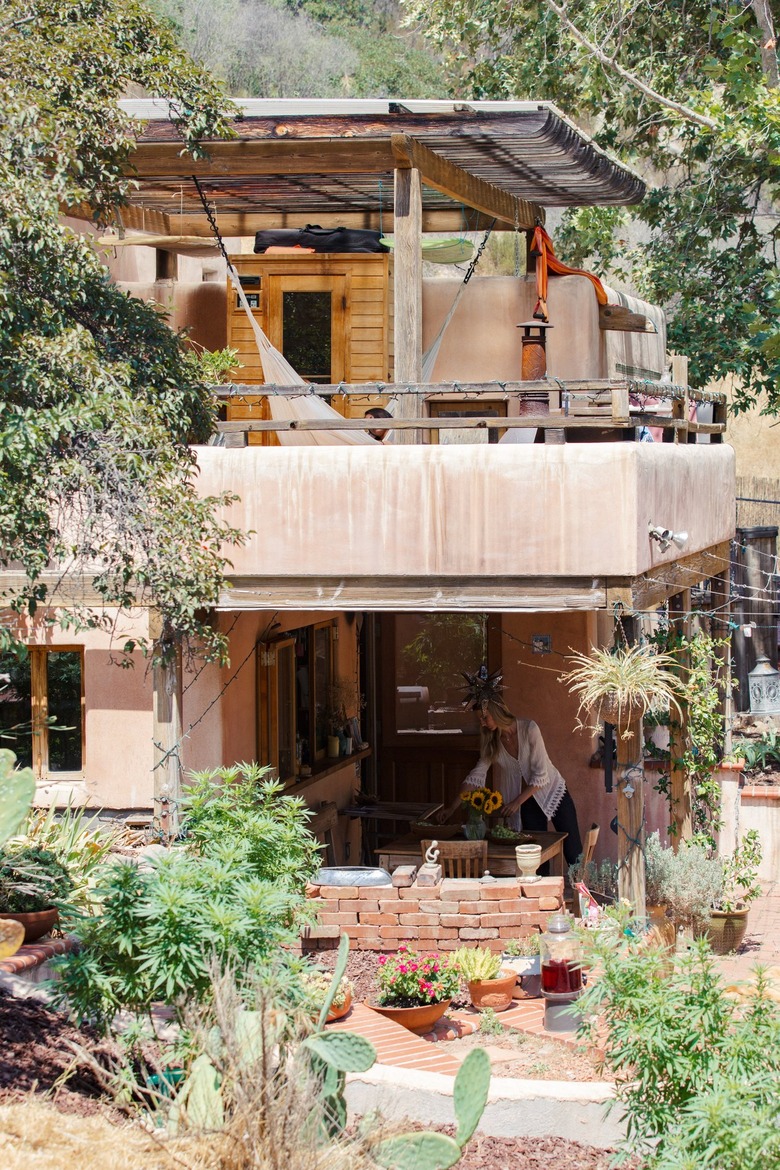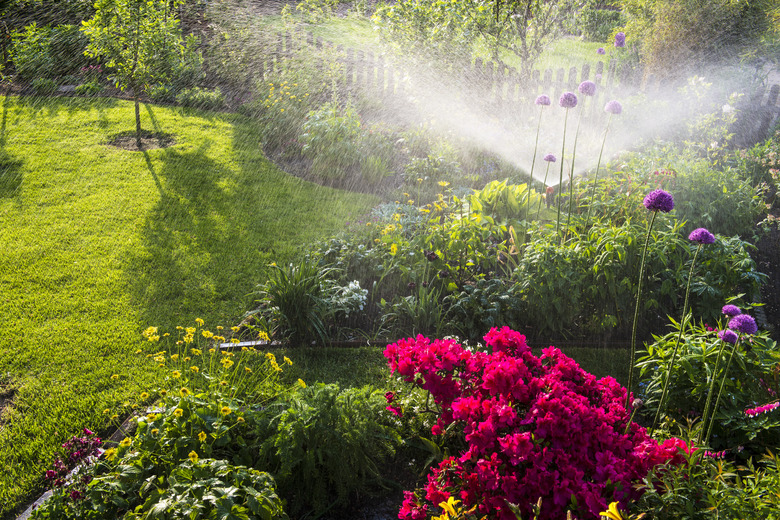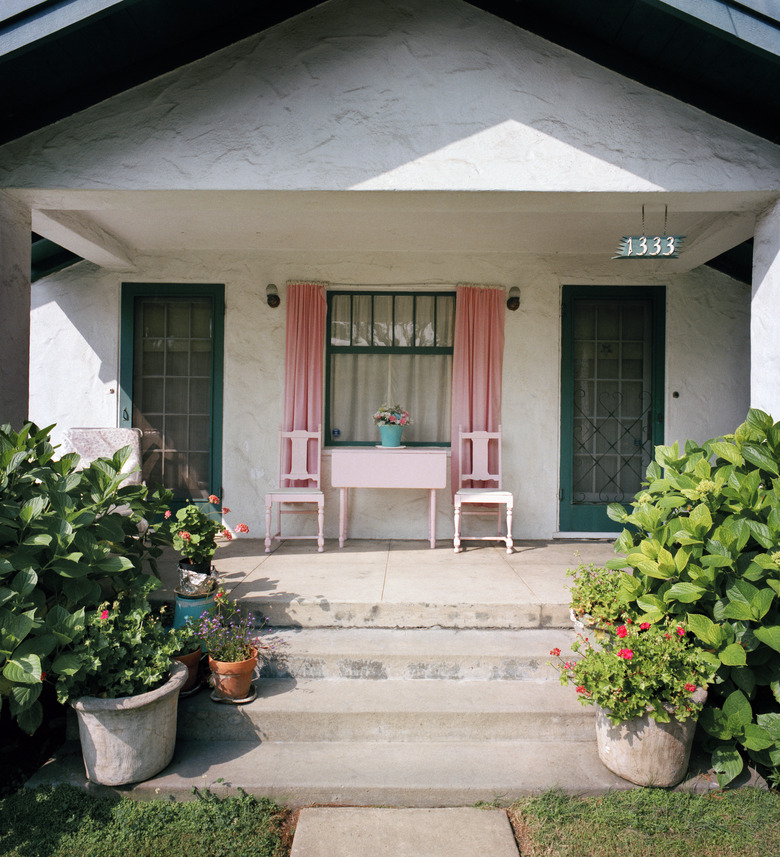Efficient Irrigation For A Water-Saving Landscape
We may receive a commission on purchases made from links.
According to the U.S. Environmental Protection Agency, the average American family uses 300 gallons of water per day, which is the equivalent of emptying and refilling a standard water heater tank almost eight times daily. That's a lot of water, and about 30 percent of it, or 2 1/2 tanks, is used outdoors, and most of that goes into the irrigation system. In arid climates, the number could be much higher in the absence of water-saving irrigation methods.
An efficient irrigation system delivers the minimum amount of water in all the right places to keep plants healthy, and drip irrigation technology was developed to do just that. Before you get to watering methods, however, there are plenty of things you can do to conserve water, including reducing the number of plants that need water in favor of hardscape features, planting drought-tolerant species, spreading mulch to keep the water in the soil and constructing drainage systems that direct water to the parts of the landscape that need it most.
Use a Water-Saving Drip Irrigation System
Use a Water-Saving Drip Irrigation System
Drip technology was developed in Israel, where water conservation is a top priority, and besides being a smart irrigation system that increases water efficiency, it's inexpensive, readily available and easy to install and maintain. A typical drip irrigation system consists of 1/2- or 5/8-inch polybutylene tubing that snakes through the landscape — often above ground, so no digging is required — and 1/4-inch branch feeder lines that terminate in drip emitters or microsprinklers. The entire system is usually controlled by a timer, and once it has been set up, it needs very little maintenance.
Drip tubing is easy to cut with a utility knife, and the tubing connectors, emitter and microsprinklers have barbed or compression fittings you just push together, so it's a flexible irrigation system that puts water exactly where you want it. You can irrigate the root zones of individual plants with emitters that deliver water at rates ranging from 1 to 4 gallons per hour, allowing you to set up a watering schedule that reduces your water bill. Use microsprinklers to irrigate groundcovers and low-growing crops, such as strawberries.
According to Interesting Engineering, drip technology boasts a water efficiency of 90 percent compared to 75 to 80 percent for a sprinkler system. Drip isn't always the best irrigation technology to use, however, particularly for watering lawns, because the above-ground tubing just gets in the way of the lawn mower. It's also subject to siphonage, which can draw in soil through the emitters that block them, and every system needs a backflow preventer to protect the water supply from contamination (as do lawn sprinkler systems).
Water-Efficient Landscape Practices
Water-Efficient Landscape Practices
One of the main techniques of xeriscaping, which is a method for creating water-efficient landscapes, is to preferentially plant species that don't need much water. Besides this, the University of Massachusetts Amherst recommends the following xeriscaping practices:
- Group plants with the same watering and maintenance needs as well as sunlight and soil-type preferences. This helps reduce watering frequency and overall water use.
- Improve the soil with compost, manure and rotted leaves to increase the plants' nutrient intake.
- Use mulch liberally to conserve soil moisture, which is one of the easiest ways to improve water efficiency. Wood chips, dead leaves and pine needles are all great natural mulching materials, but you can also use plastic sheeting, landscape fabric, old newspaper or, if you're looking for something decorative, a commercial color-enhanced wood mulch.
- Use drought-tolerant grasses, and allow turf to go dormant during periods of extreme drought. It's best to avoid narrow, isolated turf areas, as these are more difficult to water and maintain.
Harvesting rainwater can also effectively reduce water usage. One way to do this is to set up rain barrels underneath the eaves of your house and use the water they collect as irrigation water. Set the barrel on a table, attach a spigot to the bottom and when it fills, you should have plenty of pressure to water plants with a garden hose. You can also direct runoff from the gutters to water-hungry parts of the landscape using a French drain system.
Expand Hardscaping and Use Pots
Expand Hardscaping and Use Pots
You'd save a lot of water if you didn't have any plants to irrigate, but that wouldn't be much of a garden, and you don't have to go to that extreme to reduce your irrigation needs. You can, however, create more usable space with pavers and concrete, and you can adorn the extra space with potted plants, which require less water than plants in the ground. The Micro Gardener advises using light-colored pots because dark ones absorb sunlight and avoiding terra cotta and coconut-fiber pots, which leach nutrients and lose moisture more quickly than stone or glazed ceramic pots.
Use rocks and gravel liberally. You don't have to go full zen, but creating rock formations adds character and interest and provides a structure for moss (in shady locations) and drought-tolerant plants like creeping phlox (Phlox subulata), yarrow (Achillea millefolium) and the useful herb coneflower (Echinacea spp.). All these plants are perennials in USDA plant hardiness zones 3 through 9, which covers most of the continental United States.
Other ways to increase the hardscape is to increase the size of the patio, add benches and sitting areas and expand the walkways. Besides reducing the amount of water the garden needs, these improvements also reduce the amount of maintenance you have to do.
Other Water-Saving Irrigation Methods
Other Water-Saving Irrigation Methods
Despite the variety of efficient irrigation methods available, hand watering is still one of the most common methods, and it's easiest when plants with the same watering needs are grouped together. These hand-watering techniques can help reduce water usage:
- Use a nozzle or water wand. Spraying water directly from a hose is one of the least-efficient watering methods.
- Water in the early morning or early evening to allow water to sink into the soil rather than evaporating in the heat of the sun. Morning is best because fungus can attack plants that remain wet overnight.
- Move to another location when water stops seeping into the soil and begins to run off. When watering a steep slope, it's better to come back to it several times than it is to have all the water end up at the bottom of the hill. Reserve the most drought-tolerant of the species you plant for hillsides.
Sprinklers are the best watering systems for lawns and large areas of ground cover, but because the pipes are underground, a sprinkler system needs to be installed by an irrigation contractor before you do any planting. Sprinkler heads should be directional to avoid watering adjacent walkways and patios, and flow rate and direction should be calibrated to get complete coverage of the area without overwatering any part of it.
A typical sprinkler system is on a timed irrigation controller that switches it on in the early morning or late evening, but if the system turns on right after a rainstorm, that's a waste of water. To avoid this, Water Use It Wisely recommends connecting the controller to a rain sensor, which will prevent the system from turning on if it rains. A Rain Bird RSD series rain sensor is inexpensive, costing only about $20, and it can pay for itself in water savings in a single season.


